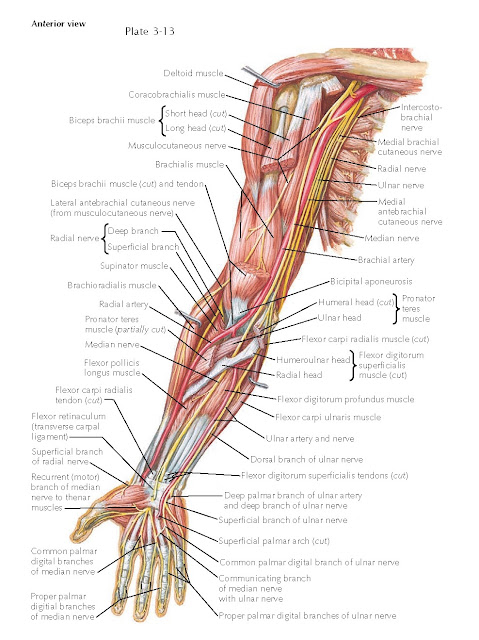BLOOD SUPPLY OF
FOREARM
The brachial artery divides into radial and ulnar arteries. Their named
branches lie near the elbow and wrist, and only unnamed muscular branches arise
in the middle forearm.
RADIAL ARTERY
This smaller branch continues the
direct line of the brachial artery, ending at the wrist at the “pulse
position.” It first crosses the tendon of the pronator teres muscle and
descends adjacent to the superficial branch of the radial nerve. It branches
into the radial recurrent artery and muscular, palmar carpal, and superficial
palmar branches.
The radial recurrent artery arises
shortly below the origin of the radial artery. Ascending on the supinator
muscle, the artery supplies this muscle and the brachioradialis and brachialis
muscles and anastomoses with the radial collateral artery (see Plate 3-8).
Muscular branches supply the muscles of the radial side of the
forearm. The palmar carpal branch arises near the distal border of the
pronator quadratus muscle. It ends by anastomosing with the palmar carpal
branch of the ulnar artery, the termination of the anterior interosseous
artery, and recurrent branches of the deep palmar arterial arch.
The superficial palmar branch leaves
the radial artery just before it turns from the radial border of the wrist onto
the back of the hand. It descends over or through the muscles of the thumb and
joins the superficial branch of the ulnar artery to form the superficial palmar
arterial arch.
ULNAR ARTERY
This larger branch describes a
gentle curve to the ulnar side of the forearm. It passes deep to both heads of
the pronator teres and all the other superficial flexor muscles of the forearm
and is crossed by the median nerve. It lies deep to the flexor carpi ulnaris
muscle and enters the hand in company with the ulnar nerve.
The anterior ulnar recurrent
artery turns upward from just below the elbow joint between the brachialis
and pronator teres muscles. It supplies these muscles and anastomoses with the
anterior branches of both ulnar collateral arteries.
The posterior ulnar recurrent
artery, larger than the anterior, arises near or in common with it. It
ascends between the flexor digitorum superficialis and flexor digitorum
profundus muscles to supply the elbow joint. It ends in anastomoses with
posterior branches of both ulnar collateral arteries and the interosseous
recurrent artery and in the network of the olecranon.
The common interosseous artery arises
from the radial side of the ulnar artery and divides into anterior and
posterior interosseous arteries. The anterior interosseous artery descends
on the anterior surface of the interosseous membrane as far as the upper border
of the pronator quadratus muscle in company with veins and the anterior
interosseous branch of the median nerve. It gives off nutrient arteries to the
radius and ulna and a long slender median artery to the palm. At the upper
border of the pronator quadratus muscle, a small palmar carpal branch is
given off. The artery terminates in the dorsal carpal network.
The posterior interosseous
artery passes to the back of the upper forearm, emerging between the
supinator and abductor pollicis longus muscles with the deep branch
of the radial nerve. Sending twigs to the extensor muscles of the forearm, it
descends to anastomose with the dorsal terminal branch of the anterior
interosseous artery. An interosseous recurrent branch ascends deep to the
supinator and anconeus muscles to the interval between the lateral epicondyle
of the humerus and the olecranon; there, it communicates with the middle
collateral, inferior ulnar collateral, and posterior ulnar recurrent arteries.
Muscular branches of the ulnar artery reach the muscles of the
ulnar side of the forearm. The palmar carpal branch arises at the upper
border of the flexor retinaculum, passes across the wrist deep to the flexor
tendons, and unites with the palmar carpal branch of the radial artery. The dorsal
carpal branch arises just above the pisiform. It winds around the border of
the wrist, deep to the tendons, to help form the dorsal carpal
arterial arch.





